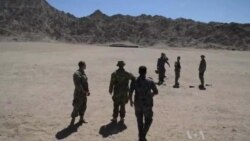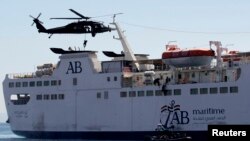PENTAGON —
The United States wrapped up a two-week military exercise with Jordan Thursday, but not all of the U.S. equipment and personnel are leaving the country. US officials last week announced a number of fighter jets and missile batteries are remaining behind to help Jordan deal with threats from the civil war in neighboring Syria.
A detachment of F-16 fighter jets and patriot missile batteries are staying at the request of Jordan.
U.S. officials say the aim is to help Jordanian forces in their efforts to prevent a spillover of the Syrian conflict.
Defense Secretary Chuck Hagel, speaking at the University of Nebraska, called the conflict complex, unpredictable and very combustible. “It has developed along dangerous sectarian lines, exposing deep historical, religious, and ethnic differences and complications. In this fluid and dynamic situation there are consequences for U.S. policy decisions, both for action and inaction," he said.
For the past two weeks, US troops have been working alongside the Jordanians and other partners in the region, conducting exercises on land, air, and sea.
The decision to leave the F-16's and Patriot missile batteries after the exercise is a show of strength -- and a message to the Syrian leadership to keep the violence away from the borders.
It comes months after the U.S. and NATO deployed Patriot batteries to Turkey.
There has been speculation that the presence of American warplanes and missile batteries in Jordan could be preparation for the eventual enforcement of a no-fly zone.
U.S. military planners say that option would require a large U.S. commitment of manpower and resources.
Analyst Elizabeth O'Bagy said that is cause for the administration to weigh its approach carefully.
“Syria is one of the few Arab countries with a well-integrated air defense system. They have actually been working with the Russians and other allies to significantly enhance their military capabilities. And from a purely military perspective, they're actually much more capable than some of the other surrounding Arab countries,” O'Bagy stated.
Despite, Washington's recent decision to provide limited lethal aid to the Syrian opposition, O'Bagy said the overall U.S. strategy on the Syrian conflict remains unclear after months of contingency planning at the Pentagon. "The general consensus coming out of those contingency plans and coming out of, specifically out of, the Defense Department has been that there is no real viable contingency plan and that any military action in Syria will be very costly and will be very difficult to implement," she stated.
The U.S. approach, for now, remains cautious and slow.
A detachment of F-16 fighter jets and patriot missile batteries are staying at the request of Jordan.
U.S. officials say the aim is to help Jordanian forces in their efforts to prevent a spillover of the Syrian conflict.
Defense Secretary Chuck Hagel, speaking at the University of Nebraska, called the conflict complex, unpredictable and very combustible. “It has developed along dangerous sectarian lines, exposing deep historical, religious, and ethnic differences and complications. In this fluid and dynamic situation there are consequences for U.S. policy decisions, both for action and inaction," he said.
For the past two weeks, US troops have been working alongside the Jordanians and other partners in the region, conducting exercises on land, air, and sea.
The decision to leave the F-16's and Patriot missile batteries after the exercise is a show of strength -- and a message to the Syrian leadership to keep the violence away from the borders.
It comes months after the U.S. and NATO deployed Patriot batteries to Turkey.
There has been speculation that the presence of American warplanes and missile batteries in Jordan could be preparation for the eventual enforcement of a no-fly zone.
U.S. military planners say that option would require a large U.S. commitment of manpower and resources.
Analyst Elizabeth O'Bagy said that is cause for the administration to weigh its approach carefully.
“Syria is one of the few Arab countries with a well-integrated air defense system. They have actually been working with the Russians and other allies to significantly enhance their military capabilities. And from a purely military perspective, they're actually much more capable than some of the other surrounding Arab countries,” O'Bagy stated.
Despite, Washington's recent decision to provide limited lethal aid to the Syrian opposition, O'Bagy said the overall U.S. strategy on the Syrian conflict remains unclear after months of contingency planning at the Pentagon. "The general consensus coming out of those contingency plans and coming out of, specifically out of, the Defense Department has been that there is no real viable contingency plan and that any military action in Syria will be very costly and will be very difficult to implement," she stated.
The U.S. approach, for now, remains cautious and slow.









